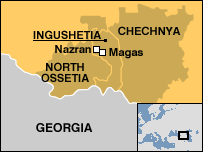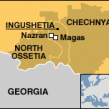
POLICE BARRACKS ATTACKED IN INGUSHETIA
Publication: Eurasia Daily Monitor Volume: 4 Issue: 121
By:

At midnight on Tuesday, June 19, a group of militants attacked a police special-task force facility in Karabulak, Ingushetia. The garrison actually had members of two special-task police units inside: an Ingush one, and another consisting of assorted Russian officers sent to the republic from all across Russia to strengthen local police forces.
According to Ingushetiya.ru, the insurgents attacked the base from two directions; shots came from a nearby traffic police post and also from neighboring residential districts. However, RIA-Novosti stated that the militants had fired only from the nearby woods. The attackers used assault rifles, machine guns, and grenade launchers. RIA-Novosti also reported that at least 20 rocket-propelled grenades had been fired at the police barracks, while Ingushetiya.ru says 30. Along with the grenades the base was under heavy gunfire. Ingushetiya.ru reported that heavy machine guns had been used; however, it is unclear whether it was the attackers or the police using them.
The gunmen fired from about 150 meters away from the base. After 40 minutes of intense gunfire, rockets appeared in the sky and then a motorcade containing 150 Russian troops reached the garrison to help the policemen. The rebel squad retreated 20 minutes after the arrival of the troops.
Official reaction to the attack was quite slow. Only Ingushetiya.ru had a correspondent reporting live from Karabulak about the latest developments. Official news agencies only mentioned the event the next morning, Wednesday, June 20. The first report from RIA-Novosti said that the police units in the garrison had “suffered losses in numbers still unknown.” The report did not sound quite truthful, because several hours had already passed since the attack ended, and there had been ample time to count the injured and the dead.
A more plausible explanation for the delay is that the officials could not decide what casualty figures they should announce to the public. Eventually, officials declared that only three policemen had been injured, one Ingush and two Russians, and the base had suffered minor damage. All three wounded officers were sent to a military hospital in Vladikavkaz, the capital of neighboring North Ossetia.
The official report says that there were between five and seven attackers. This figure is also questionable, because it is hard to believe that seven men could fire more than 20 shots from grenade launchers while simultaneously releasing a barrage of gunfire in just 30-40 minutes.
In addition, the official reports are not clear about what kind of grenade launchers the rebels used during the attack: shoulder-launched or under-barrel. This distinction is important, because a shoulder-launcher is a much more powerful weapon than a small under-barrel launcher, which is usually attached to an assault rifle. Twenty or more shots from a shoulder-launcher might have inflicted much more serious damage. A correspondent from the Russian state-controlled ORT TV channel reported at noon Wednesday — eleven hours after the fighting — that one of the grenades had not exploded and sappers were defusing it. It does not take much time to defuse a grenade from an under-barrel launcher, which is smaller than an ordinary hand-grenade, but much more time would be required to defuse a powerful rocket-propelled grenade deployed by a shoulder launcher. The attackers probably used both types of grenades, but the authorities have chosen to focus public attention on light weapons to minimize the consequences of the rebel attack.
Wednesday morning Ingush law-enforcement bodies reported that at 2:00 am, more than one hour after the end of the attack, three suspected rebels had been detained near the garrison in Karabulak. A World War II-era Mosin rifle was found in the car carrying the three young men. It is a stretch to depict these people as members of the gang that attacked the police facility, however, because the police building was attacked with modern weapons and the rebels retreated immediately after the fighting ended.
The authorities appear to be downplaying the significance of the attack and emphasize the efficiency of police work in Ingushetia. But why is this necessary when the attack was much smaller in scale than security officials had expected?
According to Ingushetiya.ru, the army and the police in Ingushetia have been on the alert for a rebel attack since June 18. That day, Magas, the local capital, was sealed off and ringed with numerous checkpoints and troops lying in ambush. Armored personnel carriers and machine gunners were posted everywhere. Russian fighter jets have started flying over the republic. The Ingush Interior Ministry had received a report that some armed rebel groups had been observed moving about in the forests. One of the Ingush deputy interior ministers told the website that there has been a considerable outflow of young people joining rebel groups and a major attack is expected, similar to the one that took place exactly three years ago (June 21-22, 2004) in Nazran.
Clearly, the attack at the police base in Karabulak cannot be compared with the massive insurgent raid in 2004. Nevertheless, this attack might be a sign of preparations for a much bigger offensive in the region or it could be just a diversion while the main attack is being prepared somewhere else in the North Caucasus.




